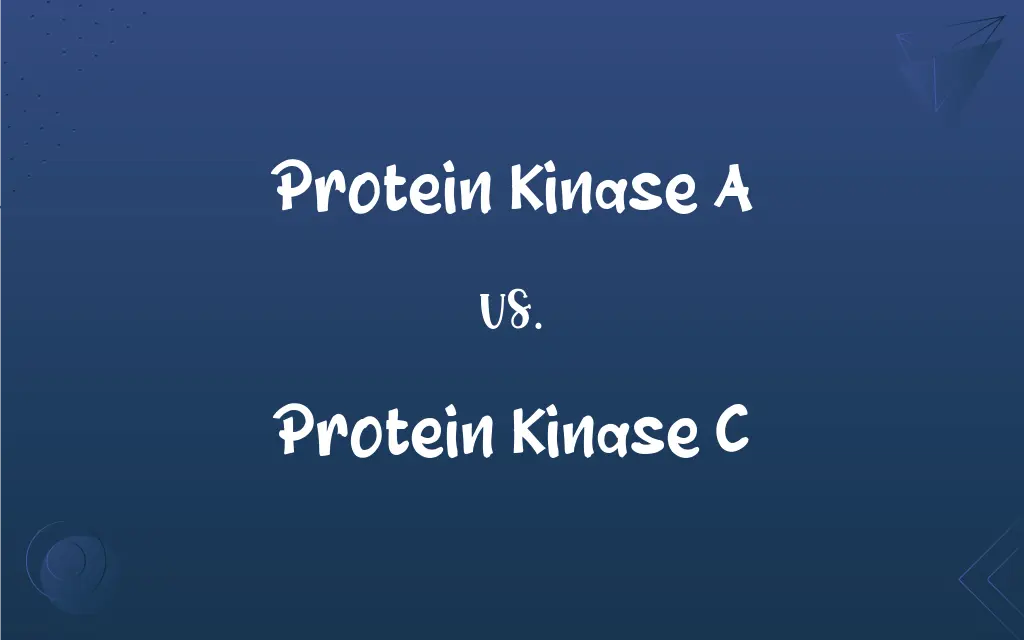Protein Kinase A vs. Protein Kinase C: What's the Difference?
Edited by Aimie Carlson || By Janet White || Published on January 25, 2024
Protein Kinase A (PKA) is activated by cyclic AMP and regulates diverse cellular functions; Protein Kinase C (PKC) is activated by calcium and lipid signals and involved in cell signaling.

Key Differences
Protein Kinase A (PKA) is an enzyme that becomes active in response to elevated levels of cyclic AMP (cAMP) in cells. Protein Kinase C (PKC) is activated by signals that increase cellular calcium levels and by the lipid diacylglycerol.
PKA primarily functions to phosphorylate target proteins, leading to changes in their activity, typically in response to hormonal signals. PKC, however, plays a crucial role in signal transduction pathways related to cellular proliferation, differentiation, and survival.
PKA is involved in regulating various cellular processes, including metabolism, gene transcription, and memory formation in the brain. In contrast, PKC is significantly involved in the immune response, neural signal processing, and cancer development.
The activation of PKA is a key step in many signaling pathways, particularly those mediated by G protein-coupled receptors. PKC, on the other hand, is involved in pathways triggered by growth factors, neurotransmitters, and other external stimuli.
PKA and PKC are both serine/threonine kinases, but they have different regulatory mechanisms and substrates, which reflects their distinct roles in cellular processes.
ADVERTISEMENT
Comparison Chart
Activation Mechanism
Activated by cyclic AMP (cAMP)
Activated by calcium ions and diacylglycerol
Main Function
Phosphorylates proteins in response to hormonal signals
Involved in cell signaling, especially in immune response and neural processes
Role in Cellular Processes
Regulates metabolism, gene transcription, and memory
Influences cellular proliferation, differentiation, and survival
Common Pathways
Mediated by G protein-coupled receptors
Triggered by growth factors and neurotransmitters
Involvement in Diseases
Dysregulation can affect metabolic and cardiac functions
Linked to cancer development and immune disorders
ADVERTISEMENT
Protein Kinase A and Protein Kinase C Definitions
Protein Kinase A
PKA functions by phosphorylating specific target proteins.
PKA activation leads to changes in heart muscle contractions.
Protein Kinase C
Protein Kinase C is activated by calcium and lipid-derived signals.
PKC activation is a key event in T-cell activation in the immune system.
Protein Kinase A
Protein Kinase A is involved in several signal transduction pathways.
PKA plays a role in the memory formation process in the brain.
Protein Kinase C
Protein Kinase C is part of numerous cellular signaling processes.
PKC is crucial in the signal transduction for inflammation.
Protein Kinase A
PKA is regulated by the intracellular levels of cyclic AMP.
The increase in cAMP levels activates PKA during hormonal signaling.
Protein Kinase C
PKC is activated by diacylglycerol and calcium ions.
Calcium influx and diacylglycerol formation trigger PKC in certain cells.
Protein Kinase A
Dysregulation of PKA can affect various physiological functions.
Abnormal PKA activity is implicated in some types of heart disease.
Protein Kinase C
PKC plays a role in cell growth, differentiation, and survival.
PKC is involved in the pathways leading to neuronal growth.
Protein Kinase A
Protein Kinase A is an enzyme that responds to cyclic AMP in cells.
PKA is crucial in the regulation of glycogen, sugar, and lipid metabolism.
Protein Kinase C
Abnormal PKC activity is associated with various diseases.
Dysregulation of PKC has been linked to cancer progression.
FAQs
What activates PKC?
Increases in calcium levels and diacylglycerol.
What is Protein Kinase C?
An enzyme activated by calcium and diacylglycerol for cell signaling.
What are the functions of PKA?
Regulates metabolism, gene transcription, and memory processes.
How does PKA affect the heart?
It influences heart muscle contractions and cardiac function.
Can PKA cause diseases?
Dysregulation can lead to metabolic and cardiac disorders.
Is PKC involved in the brain?
Yes, especially in neural signaling and growth.
What activates PKA?
Elevated levels of cyclic AMP.
What are the functions of PKC?
Involved in cell growth, differentiation, and immune response.
What is Protein Kinase A?
An enzyme that responds to cAMP for phosphorylating proteins.
Does PKA work in the immune system?
Indirectly, but it's not as central as PKC.
What types of cells use PKC?
Various, including immune cells, neurons, and some cancer cells.
How is PKA activity regulated?
By the intracellular concentration of cAMP.
Is PKC linked to cancer?
Yes, abnormal PKC activity can contribute to cancer development.
What triggers PKC in neurons?
Neurotransmitters and growth factors.
Are PKA and PKC related?
They are both serine/threonine kinases but have different roles and activation mechanisms.
Can PKC be inhibited for cancer treatment?
Research is ongoing to target PKC in cancer therapies.
What triggers PKA activation?
Hormonal signals leading to increased cAMP.
What regulates PKC activity?
Calcium ions and diacylglycerol levels in cells.
What is a common pathway for PKA?
G protein-coupled receptor pathways.
Can PKA be targeted for therapy?
Yes, in conditions like heart disease and metabolic disorders.
About Author
Written by
Janet WhiteJanet White has been an esteemed writer and blogger for Difference Wiki. Holding a Master's degree in Science and Medical Journalism from the prestigious Boston University, she has consistently demonstrated her expertise and passion for her field. When she's not immersed in her work, Janet relishes her time exercising, delving into a good book, and cherishing moments with friends and family.
Edited by
Aimie CarlsonAimie Carlson, holding a master's degree in English literature, is a fervent English language enthusiast. She lends her writing talents to Difference Wiki, a prominent website that specializes in comparisons, offering readers insightful analyses that both captivate and inform.

































































